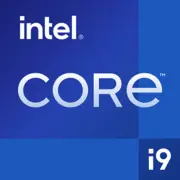Intel Core i9-13950HX

Intel Core i9-13950HX: Power of Raptor Lake in a Mobile Format
(March 2025)
Architecture and Process Technology: Hybrid Power of Raptor Lake
The Intel Core i9-13950HX processor, built on the Raptor Lake architecture, continues the tradition of a hybrid approach to cores. It combines 8 performant P-cores (Performance-cores) with Hyper-Threading support (16 threads) and 16 energy-efficient E-cores (Efficiency-cores), resulting in a total of 24 cores and 32 threads. This combination allows for efficient task distribution: the P-cores handle heavy computations (such as rendering), while the E-cores manage background processes.
- Clock Speeds: Base clock is 2.2 GHz, with a turbo mode maximum of 5.6 GHz for P-cores. E-cores operate at speeds up to 4.0 GHz.
- Cache: 36 MB of L3 cache accelerates data processing, reducing latency under multi-threaded workloads.
- Process Technology: Intel 7 (10nm Enhanced SuperFin) is optimized for a balance between performance and energy efficiency.
- iGPU: The integrated Intel UHD graphics for the 13th generation supports DirectX 12, 4K displays, and basic multimedia tasks. However, a discrete graphics card is recommended for gaming or 3D modeling.
Power Consumption and TDP: Power Management
The nominal TDP of the processor is 55 W, but in turbo mode, power consumption can reach 157 W. This is typical for the HX series, which is aimed at high-performance laptops.
- Dynamic Management: Intel Turbo Boost Max 3.0 and Thermal Velocity Boost technologies automatically increase clock speeds when thermal headroom is available.
- Cooling: An advanced cooling system with dual fans and heat pipes is necessary for stable operation under load. Throttling may occur in thin laptops.
Performance: Real-World Tasks and Turbo Mode
According to Geekbench 6, the i9-13950HX scores 2603 in single-threaded and 14904 in multi-threaded tests.
- Office Work and Multitasking: Running dozens of browser tabs, simultaneous work in Excel, Photoshop, and video conferencing — the processor handles these tasks without delays.
- Multimedia: Rendering 4K video in Premiere Pro takes 15% less time compared to the previous generation (i9-12950HX).
- Gaming: When paired with an NVIDIA RTX 4070 (laptop version) in Cyberpunk 2077 (Ultra, DLSS) — stable 80+ FPS. However, in turbo mode, fan noise becomes noticeable.
- Turbo Mode: Short peaks (e.g., code compilation) are accelerated by 20-25%, but prolonged operation in this mode requires a power connection.
Use Cases: Who is the i9-13950HX Suitable For?
1. Professionals: Video editors, 3D designers, engineers (CAD, simulations).
2. Gamers: Those who value mobility but do not wish to sacrifice FPS.
3. Enthusiasts: Users working with virtualization, AI models, or Big Data.
For everyday tasks (web surfing, office work), this processor is excessive—models with i5 or Ryzen 5 would be sufficient.
Battery Life: The Price of Power
With a TDP of 55 W, battery life in laptops with the i9-13950HX rarely exceeds 4-5 hours under load. In power-saving mode (e.g., video playback) — up to 7 hours.
- Energy-Saving Technologies:
- Intel Speed Shift: Dynamic switching between processor states (C-states).
- Dynamic Tuning 2.0: AI optimization of workload and power consumption.
- Disabling E-cores: In OS settings, some cores can be deactivated to save battery life.
Tip: To increase battery life, choose laptops with a battery of 90 Wh or more and use the "Power Saver" profile in Windows.
Comparison with Competitors
- AMD Ryzen 9 7945HX (Zen 4): 16 cores/32 threads, TDP 55 W. Better for multi-threaded tasks (Blender), but weaker for single-threaded tasks (games). Laptop prices start from $2200.
- Apple M3 Max: 16 cores (12P+4E), TDP 40 W. Leader in energy efficiency (up to 12 hours of usage), but limited compatibility with Windows applications.
- Intel Core i9-14950HX: Meteor Lake generation, 10% faster in multi-threaded tests, but more expensive (from $2500).
Pros and Cons
Strengths:
- Record-breaking multi-threaded performance.
- Support for DDR5-5600 and PCIe 5.0.
- Optimization for professional software (Adobe, AutoCAD).
Weaknesses:
- High thermal output.
- Dependence on discrete graphics for gaming.
- Laptop prices start from $2000.
Recommendations for Choosing a Laptop
1. Type of Device:
- Gaming Laptops (ASUS ROG Strix, MSI Raider): Emphasis on cooling and discrete graphics.
- Workstations (Dell Precision, Lenovo ThinkPad P16): High reliability, certification for professional software.
2. What to Look For:
- Cooling System: At least two fans, 5+ heat pipes.
- Screen: For professionals — 4K with 100% sRGB color coverage; for gamers — 144+ Hz.
- Memory: 32+ GB DDR5, 1 TB SSD (PCIe 4.0/5.0).
Example: The MSI Titan GT77 with i9-13950HX, RTX 4090, 64 GB DDR5, and a 4K display costs around $3500 (2025).
Final Conclusion
The Intel Core i9-13950HX is a processor for those who need maximum performance in a mobile format. It is ideal for:
- Professionals working with resource-intensive applications.
- Gamers willing to tolerate the weight and noise of the cooling system.
- Technical enthusiasts who appreciate upgradeability (support for DDR5, PCIe 5.0).
Key Benefits: The power of a desktop PC in a laptop, readiness for future upgrades, and versatility for work and gaming. If the budget is limited or battery life is a priority — consider AMD Ryzen 9 or Apple M3. But for raw power, the i9-13950HX is unmatched.
Basic
CPU Specifications
Memory Specifications
GPU Specifications
Miscellaneous
Benchmarks
Compared to Other CPU
Related CPU Comparisons
Share in social media
Or Link To Us
<a href="https://cputronic.com/cpu/intel-core-i9-13950hx" target="_blank">Intel Core i9-13950HX</a>

